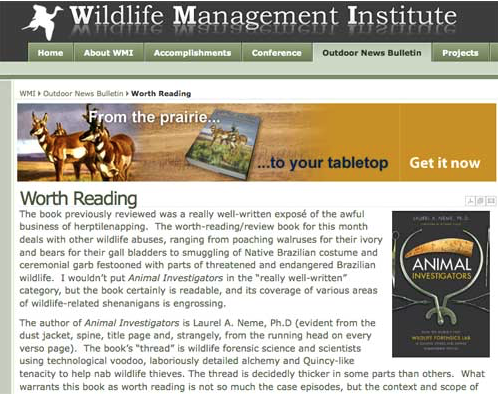Wildlife Management Institute
 Worth Reading
Worth Reading
The book previously reviewed was a really well-written exposé of the awful business of herptilenapping. The worth-reading/review book for this month deals with other wildlife abuses, ranging from poaching walruses for their ivory and bears for their gall bladders to smuggling of Native Brazilian costume and ceremonial garb festooned with parts of threatened and endangered Brazilian wildlife. I wouldn’t put Animal Investigators in the “really well-written” category, but the book certainly is readable, and its coverage of various areas of wildlife-related shenanigans is engrossing.
The author of Animal Investigators is Laurel A. Neme, Ph.D (evident from the dust jacket, spine, title page and, strangely, from the running head on every verso page). The book’s “thread” is wildlife forensic science and scientists using technological voodoo, laboriously detailed alchemy and Quincy-like tenacity to help nab wildlife thieves. The thread is decidedly thicker in some parts than others. What warrants this book as worth reading is not so much the case episodes, but the context and scope of crime that are divulged. The illegal trade in wildlife and wildlife parts and products in North America and beyond is appalling. The world, it seems, is chock full o’exploiters. By virtue of the lack of resources available to counter their abuses and by a lack of priority given to penalizing the outlaws who engage in trafficking in illegal wildlife, crimes against critters aren’t so much offensive as they are a joke. An obscene joke.
How the U.S. Fish and Wildlife Service’s Forensics Lab figured in halting or slowing the trafficking of walrus ivory (really big canine teeth), black bear bile and threatened or endangered Brazilian wildlife is interesting in a less than edge-of your-seat way, but each is a vehicle for getting at the fact that the illegal trade in wildlife is nearly out of control. Forensics, schmensics…until the trade is beyond control, based on recent evidence, not much will be done preventatively.
For example, last month’s review of The Lizard King mentioned the importation, breeding and selling of pythons. Well, guess what? After a two-year-old girl was strangled in her Florida home by an unlicensed pet python a few weeks ago, two Florida lawmakers petitioned Interior Secretary Salazar for organized python hunts in the Everglades. It seems that an estimated 100,000 pythons may be on the loose there—and surely up to no good as far as the native ecology is concerned. Reportedly, and not surprisingly, “many” of the pythons were turned loose because they got too big. Go figure.
What has to happen to walrus and black bear populations and to the endangered Brazilian macaws before teeth are put into much more effective enforcement of CITES, the Lacey Act, the Migratory Bird Treaty Act, the Endangered Species Act and other existing laws that are meant to counter biopiracy of one form or another? A 1994 General Accounting Office study showed that only 25 percent of ESA violators received any sort of penalty, far fewer had to serve any jail time or paid a fine, and repeat offenders rarely got a substantial fine or jail time.
Animal Investigators puts things in perspective. For instance, the worldwide legal trade in wildlife is $15-55 billion per year. This included approximately 25,000 primates, 2-3 million birds, 10 million reptiles (dead or alive), and 500 million tropical fish. The illegal trafficking is estimated at $20 billion; that’s with a “b”. The commercial wildlife biz is the third most lucrative trade worldwide, behind only drug and human trafficking; it obliterates the gold standard. The United States is one of the largest markets for illegal wildlife and wildlife products, and it is second only to China as the largest supplier.
Wildlife is a bad guy’s trifecta—low risk, weak penalties, high profit. In 2008, a study of online auctions and sales of protected wildlife parts in the U.S. revealed that 91 percent “probably” were illegal. The illegal, illicit trade has been characterized as “wildlife’s version of blood diamonds.” Seem overstated? Read the damning book.
The bear bile case is really fascinating, because it gets into TCM—traditional Chinese medicine. What goes into those pharmaceuticals to prevent impotence, ease arthritis, cure headaches, etc., etc., puts a serious hurt on certain wildlife, including some endangered species. The demand for these weird alternative medicines is extraordinary—the global market for TCM is $60 billion; that’s with a b. Americans alone spend about $160 million annually for alternative remedies. So? Well, for instance, if just 0.1 percent of the potential consumers of bear bile products in China, Taiwan, Japan and Korea were satisfied, the North American black bear population would be wiped out. Kaput, writes Neme. And this would only happen after the remaining Asian bears (all CITES Category I) also were history.
It is easy to put the blame on a lack of enforcement, and “lack” is an understatement. There are about 200 federal wildlife special agents and 3,300 state conservation officers. This compares with 12,000 FBI agents, 5,000 Drug Enforcement Administration special agents, 33,000 border patrol agents and 675,000 sworn state and local police. The U.S. Fish and Wildlife Service has 115 wildlife inspectors serving 17 ports and 20 other locations. At each of the major ports in the United States, approximately 20,000 containers arrive every day. Maybe 20 are inspected. Houston, Miami, New York, Los Angeles, Baltimore, we have a problem.
But lack of enforcement is an easy out. The real issue is priority in the public conscience and in the courts.
